Connect the washing machine to the water pipe with your own hands. Checking the operation of the washing machine after connection. Detailed description of the installation process
1.
2.
3.
4.
5.
The purchase of a washing machine inevitably raises the question of whether it is possible to connect it by yourself or if it is necessary to call a master for this. Connecting a washing machine to a water pipe is often considered too complicated, so many people prefer to pay for the services of a master from the service center. In fact, the work is not particularly difficult, for this you only need to have some tools.
Complete with modern washing machines such as in the photo, there are hoses for draining and supplying water, an electric cord. Everything else has to be bought additionally.
In addition to the basic set, you will need:
- ball valve to block the flow of water into the device;
- waterproof socket;
- tee for connection to a cold water pipe;
- siphon for a washbasin with a tap for connecting a drain hose.
- unpacking and removing fasteners for transportation;
- connection to the water supply;
- connection to the sewerage system (in more detail: "");
- connection to electricity.
Unpacking the washing machine and installing it
When you deliver the washing machine, you need to unpack it and check for scratches, dents and other external damage. It is also necessary to check the integrity of the drain hose and the supply cord, they are already installed on the device during delivery. If damage is found, it is better to return the product to the store and ask for a replacement.
Before considering ways to connect the washing machine to the water pipe, you must install it correctly.
Front-loading front loaders are secured with special bolts or screws, spacers to avoid imbalance during transportation. The transport bolts are at the bottom of the technique. They are unscrewed with a wrench, first one side of the machine is raised, then the other. Simultaneously, the adjusting feet are twisted as much as possible.
In some models, there are also transport screws with spacers on the rear panel - they serve to fix the drum. They are also twisted, remove the spacers and close the holes supplied with the plugs.
Buy a tee, be sure to take into account the type of thread (it is external and internal), as well as the diameter of the connected pipes. The supplied hose on both sides has a nut with an internal thread, for this reason the tap on the tee should be with an external thread having a diameter of 0.5 inches.
Before you start connecting the styralka, it is necessary to block the water in the apartment with the help of an opening valve. Also, the remains of water from the pipes merge by opening the cranes. Then on the right level the pipe is cut or sawn off. The second option involves disconnecting the pipe and flexible piping. If the pipe had to be cut, then depending on its type, either cut the thread, or use the connecting fittings.

The tee is screwed onto the pipe using a FUM tape using a swivel wrench. After that, connect the flexible hose and hose from the machine, which at both ends has a plastic nut. To connect it to the tee, use its straight end. If the device is not equipped with leakage protection, a ball valve must always be installed between the hose and the tee.
The end of the hose, which is bent at an angle of 90 degrees, is connected to the machine after installing a filter in it coarse cleaning - it should be facing the side of the stylus with its convex side. The nuts on the hose can be tightened by hand, without special efforts, since the tightness of the connection is provided by a rubber gasket. Thus, you can be sure that the connection scheme of the washing machine to the water pipe is quite simple.
Connecting the washing machine to the sewer
Drain water from the washing machine can be made both in the bathtub and directly into the sewer (read: ""). In the first case, everything is simple: you just need to lower the corrugated hose in the bath before you start washing. But this method has some drawbacks. First of all, the bathroom can not be used during washing, and in addition, if the hose breaks under the pressure of water, this can result in the flooding of neighbors as a result.
Drain to the sewer is connected with a siphon with a special tap. A direct connection to the pipe is also possible. In this work, you must follow certain rules. The hose must be bent so that the distance in its upper part to the floor is at least 70-80 centimeters, and a hydraulic seal is formed. If the drain is connected to the siphon, it is important to ensure a good clearance of the sewage pipes and the absence of clogging (in more detail: "").
Electrical connection
Washing machines are usually installed in bathrooms, which are potentially dangerous rooms with a high level of humidity. For this reason, the socket for the machine must be waterproof. Also it is worth considering that the casing of the styralka is metal, therefore, there must be a grounding conductor in the socket. In new homes, usually grounding is carried out in compliance with all standards, but in old houses only two wires are connected to the outlet. In this case, a wiring is required to connect the machine through an RCD with a leakage current of less than 30 mA.First use of washing machine
First you need to do a trial wash in accordance with the manufacturer's recommendations regarding the weight and the regimen specified in the instructions.Before switching on, make sure that the device is level and firm, and if necessary adjust the legs. Then you should turn on the machine in the socket, open the ball valve on the hose, if it is, select the mode, fill the powder and turn on the device. If leaks were found, after the end of washing it is necessary to disconnect the machine from the mains and check whether the gaskets fit tightly, whether the nuts are skewed.
At last your dream has come true - in the house has appeared. Washing now becomes a pleasure! But before this happens, you need to install and connect the washing unit. You can do it yourself, you do not need to invite specialists.
First of all, carefully read the instructions to your washing machine. Unpack it and remove the seals located on the sides of the machine (if any). Then carefully look, whether there are scratches on the machine or any defects, and also check up a complete set. And if everything is in order, you can install the washing machine in a permanent place. For successful operation of the machine it is necessary to connect it to electricity, water supply and sewerage system.
Installing and connecting a washing machine
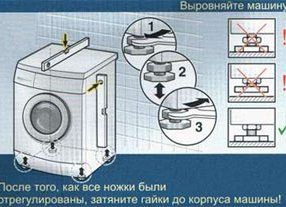
Check the strength of all joints and joints again. You can turn on the water and open the tap, letting water into the machine. And now it's time to start a trial wash. To do this, select the program that is minimal in time, and select the maximum temperature (this is required to remove residual grease from the machine). Closely monitor the process: is there no leaks, does not "pluck" the electricity of the car body, does not it "jump". And if the installation of the washing machine you had the right, then the washing will be successful.
A person who came up with the idea to automate a washing machine should become a comic book hero, he just needs to be immortalized and glorified! Life with automatic "dumb" did not turn into a paradise, but it became much easier to plan time and not spend it on hours of washing, boiling and other "delights."
A good attitude to the washing machine must be in every home. How to connect, and it will call! There are several options for connecting the washing machine to the water supply and sewerage. Consider them carefully to connect and forget.
Before you start to connect the machine to the water supply and drain, you need to choose a place for it.
The best place is considered to be a bathroom. The availability of communications, the proper purpose and the opportunity not to expose the everyday part of life for everyone to see, are very convenient. But, quite often the space in the bathroom is not enough for the installation of a large household appliance. In this case, the compactness of some, which was invented for such cases, can help out.
Very convenient is the sink designed by designers to be placed above the washing machine. The shell differs a little depth and is slightly higher than the generally accepted standards. But these shortcomings are more than offset by the functionality of the subject. The big economy of space, preservation of comfort and the appeared opportunity to put household appliances in the bathroom, is worth giving preference to this sink.
Sink over the washing machine
Separate bathroom is quite suitable for installing a washing machine. In this case, the choice of the model of the car should be approached thoughtfully. Since the inspection hatch in the front of the machine takes up a lot of space when opening, this model rarely suits the dimensions of the toilet. But the machines with top loading will do, as they are more compact, the hatch for feeding the laundry opens from the top, which does not take up additional space. In addition, machines with top loading have a more reliable fastening (two fixing axes) of the rotating drum.
If there is enough space in your house, then it is worthwhile to think about diverting a separate room for domestic needs, where the washing machine will fit and will organically occupy its place in the household block. This is very convenient, especially if you also mount a drying machine, ironing board and others appliances, which by no means adorn the interior of the remaining rooms of the house.
 Homeblock in the house
Homeblock in the house But, in most cases, you have to place a washing machine in one of three places:
- bathroom;
- restroom;
- kitchen.
In one of these premises for the assistant there will most likely be a place, and the rest is the matter of technology: the connection of the washing machine to the water supply and sewage has several options.
Unzip and save
Arriving the car must be properly unpacked, and it's not just to remove cardboard and foam, there are some subtleties that need to be considered and strictly observed.
After removing the protective packaging, dismantle the transport fasteners. Use for this purpose the instruction, there in detail it is described which parts should be removed. When dismantling, note that after removing the safety bolts, the drum will slightly sag. Do not forget to insert the plugs into the holes of the removed bolts (included in the package).
 Supply and discharge of water in a washing machine
Supply and discharge of water in a washing machine Save the packing and shipping material, for warranty service, their availability and safety is necessary.
The base on which the washing machine will stand must be concrete. It is desirable without gradients - horizontal, a little more dimensions of the machine, the area for installation of machinery.
Water connection
1. To the metal pipe: for a frame in metal pipe water supply requires a crimp coupling, a valve regulating the supply of water, a hose. Shut off the water supply, put on the crimp clutch and fasten it well with the bolts. Through the sleeve, drill a hole in the pipe, make sure that the hole is not through, it must be done only on the front wall. On the threaded socket of the coupling screw ball valve. For safety on the threaded connection, rewind the fumble, so that there can be no leakage. Fumla is used only when the washing machine is connected to metal pipe communications.
 Crimp connection for washing machine
Crimp connection for washing machine 2 . To the expansion tank tube in the toilet or to the mixer: a crane-tee, flexible hose, fumpling is necessary. This method of connecting the washing machine is considered temporary, but sometimes it can only be used in small spaces of our bathrooms. Twist the water supply hose with the toilet bowl, mount the tee into this place and attach the hose of the tank and the hose of the washing machine. In all jobs with threaded connections, use seals suitable for the type of pipes: fumble, rubber seals, sanitary napkins, etc.
 Connecting the washing machine to the toilet bowl
Connecting the washing machine to the toilet bowl When connecting the washing machine to the water supply communication, it is desirable to install a filter that provides water softening. In this case, it will be necessary to call a specialist for preventive work: the solids depositing on the internal parts and the heating element of the machine will be less, which will increase the service life and safety of the device.
Connection to sewage
1. Connect directly to the sewer pipe: a corrugated hose and a rubber seal are required. Drain the corrugated hose of the washing machine on the back of the washing machine to a special clamp (it is provided by the manufacturer). Attach it to the seal, which in turn, secure on the sewer pipe.
To unpleasant smells of sewage do not get into the washing machine, fix the corrugated drain pipe to the adapter with the letter S, in this case the bend of the pipe will serve as a siphon. This same method will protect the washing machine from getting drained water into the system.
2. Connection to an existing drain: purchase an additional knee for the siphon siphon with a tap for connecting the hose of the washing machine, a long drain hose (the standard one that comes with the kit may not suffice). Disassemble the siphon under the sink, install an additional elbow with a tap, connect the structure to the sink. Now you can attach the drain of the washing machine to the tap under the sink and fix it well.
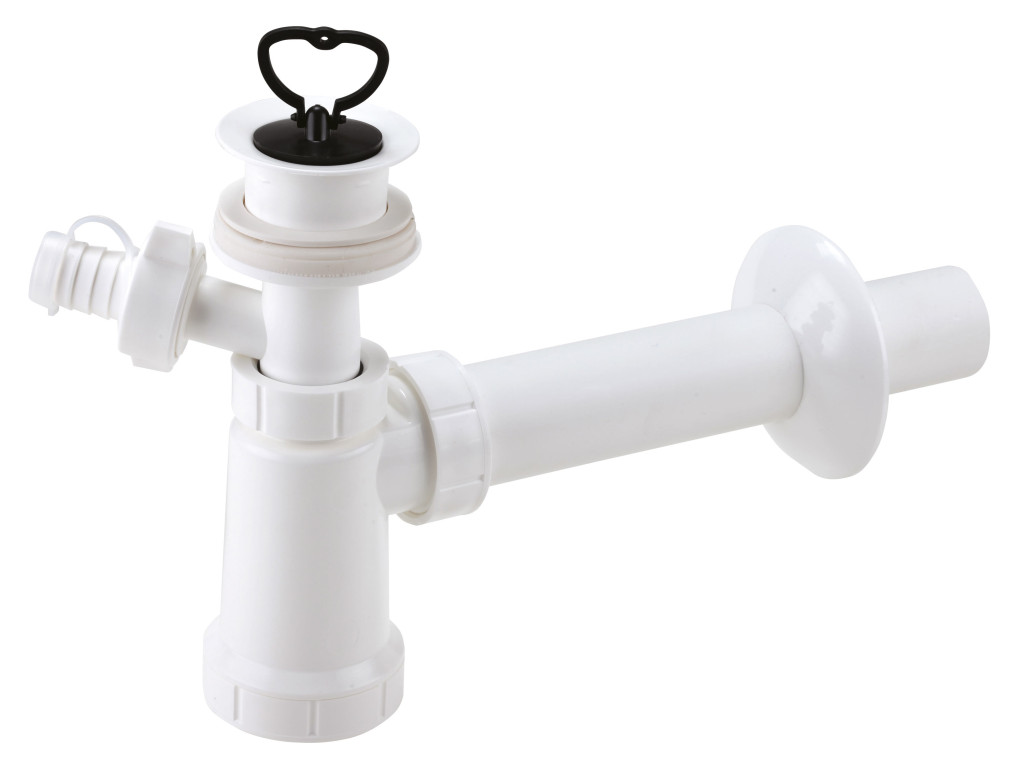 Siphon for sewage connection
Siphon for sewage connection The additional knee is attached above the siphon.
3. Draining of water without connection. If there is no possibility of connecting the washing machine to the drainage communication, then the water is disposed of directly into the sink, bathtub, toilet bowl. The set of the washing machine includes a pipe fitting with a free end to the drainage pipe, and the bent part is fixed to the plumbing. In this case, it is worth considering additional fastening, so that the pipe does not fall to the floor, which often happens, and then repair is necessary for you and your neighbors.
Connecting the washing machine to the communications
Electrical connection
Connecting the washing machine to the water supply and sewage system is only part of the solved tasks, it remains to connect to electrical network.
A feature of complex large-sized devices is the need for grounding.
For a washing machine, this is doubly relevant, since it is an electrical appliance that uses water. The connection of water and electricity with improper operation and without precautions leads to tragic consequences. For a secure connection, ground the electrical panel with a tire with a cross section of more than three millimeters. To connect the washing machine requires a three-wire socket (phase + zero + earth) The ground wire is insulated.
Earthing can not be connected to batteries, gas pipes etc.
Final touches
The washing machine makes life easy, but it also requires attention. After connecting the washing machine to the water supply and sewerage, check the horizontal position of the washing machine on the floor surface with a level. If necessary, adjust the legs of the machine and reach a level position. Otherwise, the rotating mechanism will become unusable and require repair, replacement or a new machine, which is always costly and troublesome.
 Built-in washing machine
Built-in washing machine After connecting to the communications, mains and horizontal position adjustment, the washing machine must be checked.
Parameters of normal operation of the washing machine:
- The water intake occurs quickly and up to a certain point.
- The water supply unit does not leak.
- Heating of the water to the set temperature takes place five to seven minutes after pumping into the drum.
- Rotation of the drum during washing cycles occurs practically without noise and extraneous sounds.
- Draining of waste water occurs on time and completely.
- No leakage in the drainage junction.
- The spinning is carried out at the working speed.
- The machine does not move during operation.
Having installed an automatic washing machine in the house, enjoy free time, clean linen and a new quality of comfort in life. Take care of household appliances and use them for many years.
Installing the washing machine (video)
To install a washing machine it is not necessary to call a master whose services will not be expensive. Using the recommendations of the manufacturer, how to connect a washing machine yourself, you will be able to correctly implement all the necessary manipulations with minimal financial costs.
First of all, you need to think about the place where the unit will be installed. Modern models that require connection to water and sewerage, have a stationary placement, since their transfer is very difficult.
When determining the location of the machine, it is necessary to take into account factors such as:
- available near the water supply and sanitation system;
- possibility of easy connection to the mains (preferably not through an extension cable, but directly);
- the presence of an even (better reinforced) floor;
- a harmonious combination of the washing device with the interior of the room;
- free access from all sides: in addition to easy loading of laundry, it is important to have a clearance from the side of the wall so that you can get accidentally dropped underwear or another object.
In practice, washing devices are usually put in the bathroom, in the kitchen or in the corridor.
Bathroom. This is the traditional location of the machine, as in this room, which has all the necessary communications, it is easy to equip a drain and supply water.
The disadvantages of this option include the miniature size of most bathrooms, which is why the owners often have to choose compact models. In addition, for such spaces is characterized by high humidity, which can affect both the state of electrical wiring and the health of various parts of the "washers".
Kitchen. This room is also often used to mount the unit, which is usually installed under the sink or next to the sink. Since this room is usually also small in size, washing here sometimes hinders the owner. In addition, the temperature and humidity conditions in the kitchen also do not always correspond to the rules for the operation of washing machines.
Automatic typewriters are often used in kitchens. In this case, both built-in and conventional models can be used
Entrance hall and other office space. An unusual, but quite acceptable option is to install automatic device in the hallway, closet, utility room or even a spacious closet. The only obstacle in this case may be the lack of easy access to communication systems.
The purchased machine is delivered to the apartment in a packed form. All rotating parts are fixed by fastening elements (bolts, bars, staples), which protect the device from accidental damage during transportation.

Before starting the installation, it is important to remove all fasteners (bolts, clamps, clamps) that protect the machine parts during transport
The imported "styralku" should be released from the box, after which it is necessary to remove the fixing parts:
- From the rear wall of the unit you need to remove the clamps, which are installed for the rigidity required for the transport of household appliances. Similar elements are also held by the flexible parts of the structure, namely the hose and electric cord.
- After this, it is necessary to remove the bars laid between the tank and the body of the device. To do this, it is enough to tilt the "stick" forward slightly.
- It is also necessary to remove the bolts that are installed on the front of the machine to fix the drum. In the holes from the removed elements, it is better to insert plastic plugs immediately (they are usually included in the model kit).
The released fasteners must be carefully packed and stored: they can be used when contacting the customer service.
Steps of connecting the machine
To start the operation of the washing device, the following steps must be performed correctly:
- align the device, giving it an optimal position;
- to connect to a water pipe for a water intake, necessary at washing;
- connect to the sewer to drain the water when implementing the set program (washing, soaking, rinsing, spinning);
- connect to the mains to ensure the supply of electric current, which drives the motor of the unit.
Aligning the washing machine
For the automatic machine to be used with maximum efficiency, its installation should be approached with the utmost care. Particular attention requires a floor foundation, which must meet a number of criteria:
- strictly horizontal surface;
- strong structure;
- sustainability;
- protection from vibration and other influences that are unavoidable in the operation of the unit.
If the basis does not meet this criterion, it is better to take measures to implement them. On fragile surfaces it is desirable to produce a cement-sand screed or to strengthen existing floors in the place of the alleged installation of a washing device.

The diagram clearly shows how to adjust the height of the legs of the washing machine, which is necessary to give it an immaculately horizontal position
After making sure that the base meets all the previously mentioned requirements, you can proceed with installation.
Completely unpacked machine with the retracted fastening elements is put on the chosen place. On the upper surface, the horizontal orientation of the installation is determined, while the deflection angle, which is checked on the top cover, should not exceed two degrees. Exceeding this indicator leads to a sharp increase in vibration, which has a very negative effect on the condition of the nodes and significantly shortens the life of the machine.
Adjustment of the position of the unit is achieved by changing the height of the support legs: to increase the distance from the floor, they can be unscrewed, and to reduce - to screw.
It is strictly forbidden to put under them improvised materials that can slip out from under the supports during work, which can lead to the creation of an emergency situation. At the same time, it is allowed (and even recommended) to put a mat of fine rubber on a sliding tile surface.
As soon as the body of the machine takes an ideally horizontal position, tighten the locknuts counter-clockwise, fixing the optimum height of the support legs.
- the greatest degree of stability of the unit is achieved with maximally screwed up adjusting supports, but this option is only permissible for a perfectly flat surface;
- when installing the machine on an inclined floor for fixing supporting structures, it is advisable to use fixing parts;
- to check whether the unit is correctly installed, you need to try to swing it diagonally. If the process is done correctly, there is no free stroke or its amplitude is the same for different diagonals.
After verifying the correct position of the unit, you can proceed to the next steps.
Connecting the machine to the water supply
The most difficult and responsible part of the installation of the machine is its connection to the water supply system. To do this, you should:
- Evaluate the location of the unit to choose the connection method, on which the selection of hoses, fittings, fittings depends.
- When determining the required length of flexible pipes, it is important to consider that they should be placed behind furniture and plumbing devices, so that they do not interfere with walking.
- As a rule, complete with a machine hoses are offered, however their size is often insufficient. In this case, it is better to purchase extension cords that facilitate the installation.
- Required elements for connecting the "stilalki" to the water pipe is also a ball valve or a valve, the choice of which depends on the layout features.
Usually, the connection is made on the straight section of the pipeline, using a tee or a tube of the pipe, to which is attached a flexible connection from the toilet bowl. Sometimes it is more convenient to apply fasteners to the mixer (when pumping cold water to it). It is also possible to connect the unit by means of an additional mortise clamp.
Preparation of materials and tools
To connect to a metal pipeline, you will need gas and wrench wrenches, as well as gaskets - FUM tape or carded linen (preference is best given to the latter, since it swells under the influence of moisture).

To connect the washing machine to the water supply system, you will need flexible hoses, fittings of different types, as well as all kinds of fittings
If we are talking about a sidebar to an internal water pipe made of polymers, we will have to use special equipment for soldering plastic pipes, calibrator, as well as special fittings designed for plastic and metal-plastic.
Having prepared everything you need, you can proceed directly to the connection of the washing machine to the water.
Fastening the hose to the washing machine
First of all, you must connect the enclosed or purchased separately hose directly to the unit. To do this, you should:
- in the end of the hose expose the filter (its convex edge should be directed toward the direction of the washing machine;
- tighten the nut in the place where the hose is fastened to the device. The tightening is done manually, the use of keys is undesirable. Rubber seals used for fastening, promote tightness of the connection.
After this, it is possible to start connecting the machine to the water source. There are several possible options.
Connecting the "machine" to the toilet
The easiest and quickest way to connect the washing device to water supply, which has become widespread. Instead of complex installation operations, it is enough to make a few elementary steps, even for a beginner.

The easiest way to connect the machine to the water pipe, using the toilet bowl. This elementary manipulation is easily performed even by a beginner
To connect, you must:
- remove flexible piping from the tube;
- wind the fitting-tee;
- connect to it a flexible piping from the tank and a hose for supplying water to the "stylalka" through the valve or shut-off valve.
Unfortunately, this option can not be used when installing a washing device in a separate bathroom or kitchen, because the automatic unit and toilet should be in the same room, preferably a short distance from each other.
Attaching the machine hose to the mixer
A popular option is also to connect the washing unit to the mixer, which can be used in almost any room.
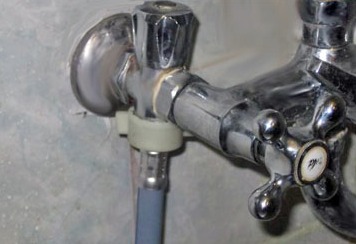
The water supply to the unit can be ensured by connecting the machine to the mixer. This is a fairly easy way, which can be applied not only in the bathroom, but also in the kitchen
For this method, a special version of the tee is required, the design of which provides for an integrated ball valve. This part is installed in the space between the cold water supply tap in the mixer, cold water to the same detail.
This method is reliable and simple, but it has a significant disadvantage, because the hose, by which the water pipe is connected to the "stick", is always in sight. You can hide it by arranging a box with the subsequent finishing with tiles.
Cutting into a plastic or polypropylene pipe
The connection of the "automatic machine" to the communications from the metal-plastic can be done almost anywhere. To do this, it is sufficient to cut the pipe by installing a metal tee in place of the cut, thanks to which it is possible to make a branch of the communication to the washing unit.

It is also possible to connect the "stylalki" to the metal-plastic pipe. To do this, a special fitting is installed on the pipeline section, to the end of which a hose
To perform this operation, you must take the following steps:
- cut the pipe;
- measure the parameters of the fitting (tee);
- cut off a piece of pipe corresponding to the adapter;
- fasten the connecting ring to the nut;
- with the help of a special tool - calibrator - to expand the ends of the pipe in the places of connection with the tee;
- put the pipe on the fitting fitting;
- push the O-rings from both ends, then tighten the nuts tightly.
The shut-off valve to the adapter must be screwed in advance, before the start of the frame. This will avoid damage to a sufficiently flexible metal-plastic pipe. After the connection of the tee is complete, flexible water hoses are fastened to the screwed tap.
If the apartment has a plastic pipeline, you will need a complicated version of connecting the "stilalki". In this case, to perform installation works need not only special fittings, but also a special tool that allows soldering pipe fasteners with adapters.
In this case, a tee is installed on the cold water pipe, to which a hose connected to the "automatic" is connected through a shut-off valve.
Connection to water supply in any place
In some cases, it is convenient to connect the washing device to a specific location in the straight pipe. To perform this operation, you will need a special adapter - a coupling saddle, which is a clamp from the clip with a threaded tap.

This figure shows a schematic representation of the coupling-saddle, by means of which it is possible to connect the automatic machine practically anywhere in the straight pipe
You can buy a similar element at specialized outlets, and it is important to pay attention to the diameter of the fitting, which must match the size of the pipe.
An integral part of the saddle is a collapsible cage: its construction is assembled on the pipe at the point of connection of the "stylalki" to the water supply, and it is important to use a reliable gasket.
The adapter firmly fixed on the desired fragment blocks the flow of water. After that, a hole is drilled through the branch pipe of the saddle. A valve (ball valve) is wound on the coupling outlet, which is used to connect a hose that supplies the washing machine with water.
For greater comfort during operation, it is also possible to connect to the crane unit.
Use of "automatic machine" in the absence of a water pipe
The operation of automated washing devices is possible in the case of water supply under pressure. The lack of a water pipe in a dacha or in a private home does not mean abandoning the usual amenities, because in this case you can use an alternative solution.
To use a modern machine, it is enough to lift a volumetric water tank to a certain height (at least one meter), to the bottom of which you need to connect a hose leading to the corresponding outlet of the unit. Water in the container should be poured in a timely manner.
Cardinally solve the problem with the help of a purchase pumping station. However, because of the high price, this option is usually considered for permanent residence in a house without water supply.
Connection to sewerage systems
Connecting the washing machine to the sewage system allows to solve the task of draining dirty water, which remains after washing. You can do this by applying different schemes:
- Temporary, by using a special hose, sent to the toilet or bath.
- Constant, providing a device for stationary drainage.
The first method is very simple: drainage of water is made through a hose that is attached to the edge of the bathroom, toilet bowl or sink, which can be done with the help of special fixing elements.
In the second case, two options are possible. The discharge is carried out with the help of a siphon of special design, in which there is a separate tap for connection of "automatic machines", placed under the siphon bend. It is not necessary to replace a similar device with a conventional analog, since it will hold back the waste water, spreading an unpleasant smell.

This diagram shows the variant of connecting the "automatic" to sewage system with the use of a siphon of special design, providing a special hose outlet
The washing machine can also be connected without a siphon. With a sewer pipe diameter of 4-5 cm, the branch for the machine of the machine can be connected directly to this element.
In this case, the S-curved drain hose is inserted into the pipe so that it does not touch the sewage, and then is carefully surrounded by the seal and sealed. The distance from the inflection point to the floor should exceed 0.5 m.
The maximum length of the hose is usually indicated in the instructions accompanying the model. If you select a larger part, the load on the pump will increase dramatically, which can lead to unforeseen breakdown.
If the design of the washing unit does not provide a check valve, then when mounting the model, there is a restriction on the height on which the drain hose is located. Specific information the manufacturer, usually leads to the manual.
Features of connection to the electrical network
Specific information on how to correctly connect the newly purchased washing machine to the electrical network, you can read the instructions. Particular attention should be given to safety rules, since the device has a high level of power consumption (1.5 - 2.5 kW), and also comes into contact with water.
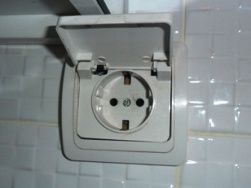
To connect the unit to the mains it is important to carefully select the outlet. The device must necessarily have a ground, in addition, it is desirable to choose a model with a cover
As a rule, a three-wire socket is needed to connect the washing machine manually, in which there is a phase, zero and a carefully insulated ground wire. The distribution board is grounded by using a special busbar with a cross section of at least 0.3 cm.
When connecting, it is advisable to follow several recommendations:
- Optimal option - individual power supply. In this case, the "washer" is fed from the switchboard by a separate input, and the power is supplied via the additional power cables that are laid. That the wires do not spoil the interior, they can be placed in neat plastic boxes.
- Application of specialized electrical protection devices. In addition to the mandatory automatic switches In the power line of the machine, it is recommended to install the device in addition protective shutdown (RCD).
- Strict conformity of all components electrical circuits required technical / operational characteristics. For conducting wiring it is important to use three-core cables, while the cross-sectional area should exceed 1.5 cm2.
- Connect the socket according to the scheme specified in the instructions. It is important to observe the mandatory condition - the presence of a protective earth. The connection of the wire is mandatory to the grounding bus of the switchboard.
- Connecting the conductor to heating or water pipelines is strictly prohibited, as this can lead not only to the failure of the machine, but also to the creation of emergency situations.
- When choosing models it is better to give preference to rosettes having a high degree of safety; it is desirable that they have a lid protecting from moisture and a ceramic base.
- When connecting the washing machine, extenders, tees and adapters should be avoided: the additional connections that are inevitable in this case may cause a temperature rise in the contacts, which leads to a breakdown of the unit.
It is undesirable that the outlet for the machine is in rooms with a permanent high humidity. If the length of the electrical cord is sufficient, it is better to place the supply device in an adjacent space, for example, a corridor.
Checking the operation of the machine in all modes
After completing all the above work, you need to check the correct installation.
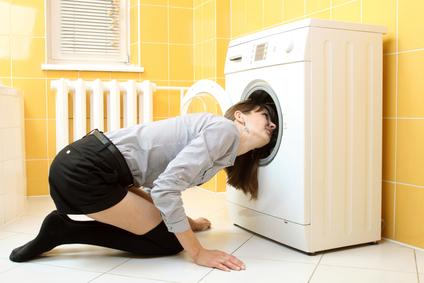
The final stage of the work is to check all systems of the washing machine. It should be carried out strictly according to instructions and affect all aspects of the connection
To do this, you need to inspect all the assembled nodes, and then run a test run of the machine without laundry, during which you need to pay attention to the following options:
- period of time (it should be small), for which the tank is being recruited;
- absence of leaks;
- correct operation of the drain;
- uniform rotation of the drum;
- good spin;
- full-fledged heating of water, which is produced after 5-7 minutes after the completion of water recruitment.
At all stages of the unit operation, there should be no extraneous sounds.
The presented roller explains in detail the process of connecting the unit to the water supply, electricity and sewerage.
Exactly following detailed instructions, how to connect the washing machine to all communications with your own hands, with the installation of household appliances can be handled quickly and easily.



